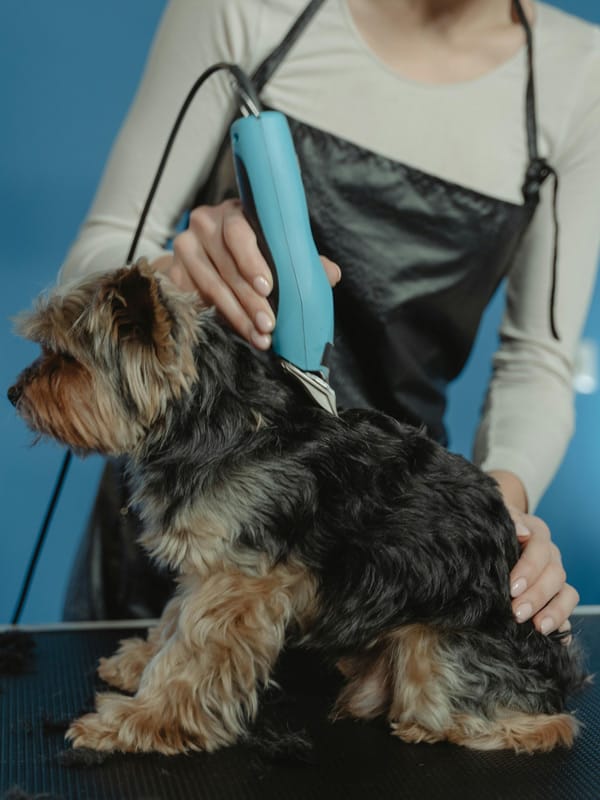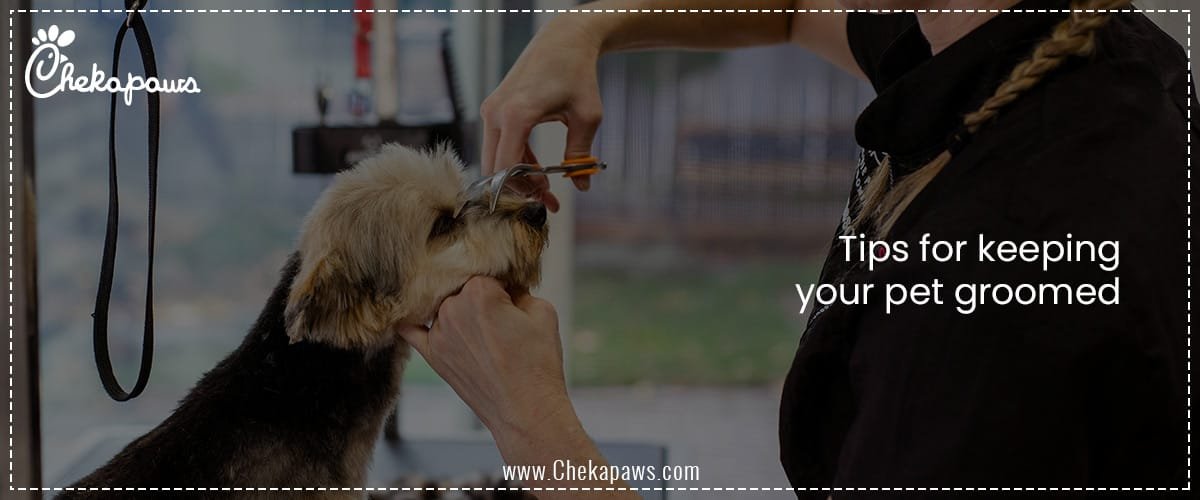As a pet parent, I know that maintaining your pet’s grooming is important for their health, hygiene, and strengthening their relationship with you. Regular grooming keeps your pet clean, comfortable, and content, whether you have a guinea pig, a long-haired Persian cat, or a scruffy terrier. It’s a means of detecting health problems early and avoiding infections, parasites, and matting.
When grooming is done correctly, it can be a soothing and enriching experience that also gives you valuable one-on-one time with your pet. When introduced early and handled carefully and patiently, many pets come to appreciate the process.
From daily brushing to seasonal coat management and safe bathing practices, this thorough guide will guide you through grooming methods, supplies, and routines for pets of all kinds. These suggestions will help you maintain your furry (or even avian) friend’s finest appearance and well-being, regardless of whether you’re a first-time pet owner or wish to enhance your grooming regimen.
Table of Contents

Why Grooming Matters for Your Pet’s Health
Grooming is a preventative health practice in addition to a preventive procedure.
Skin and Coat Health – A clean coat eliminates dirt, dander, and dead hair while also promoting healthy skin and avoiding annoying tangles. Natural oil production is stimulated by grooming, keeping fur healthy and lustrous.
Early Issue Identification – You’re also looking for lumps, sores, rashes, parasites, or indications of discomfort when you brush or bathe your pet. Early intervention is a result of early detection.
Control of Parasites – The coat of your pet can conceal fleas, ticks, and mites. Grooming makes it easier to identify them and take action before an infestation becomes worse.
Management of Allergies – Grooming lowers allergens such as dust, dander, and saliva in fur for pets (or owners) with allergies.
Comfort and Conduct – Ear infections, matted fur, or long nails can all cause excruciating pain, which can affect behaviour. Frequent grooming eliminates these annoyances, encouraging more composed conduct and an improved standard of living.
Improved Bonding – Touch fosters trust. Regular, gentle grooming improves your relationship with your pet and builds positive associations.
Establishing a Grooming Routine
Maintaining a regular grooming schedule helps your pet feel less anxious by setting expectations. Here’s how to set one up
Get Started Early – When your pet is young or new to your house, start grooming them. Getting acclimated to handling is crucial, even if they don’t require a bath or trimming just yet.
Establish a Calm Ambience – Select a distraction-free, peaceful time and location. To help your pet relax, use slow motions and calming music.
First, keep sessions brief – Begin with sessions of five to ten minutes. As your pet feels more at ease, extend them.
Reward Good Behavior – When grooming, reward calm behavior with toys, rewards, or praise.
Maintain a Schedule – Depending on the pet, monthly baths, weekly nail inspections, and daily brushing aid in acclimatisation.
Monitor Your Daily Schedule – Record the dates of baths, brushings, nail trims, and veterinary visits in a grooming journal or app. This makes it easier to spot trends or modifications in your pet’s health.
Brushing Your Pet’s Coat
Regular brushing keeps coats tangle-free and lustrous.
What’s the Ideal Brushing Frequency?
- Dogs and cats with short hair: once or twice a week
- Breeds with long hair: Every day
- Huskies and other double-coated dogs: Every other day, particularly during the shedding season
- One to three times a week, exotic pets (guinea pigs, rabbits)
Selecting the Proper Brush
For getting rid of tangles in thick or long fur, a slicker brush is ideal.
- Bristle brush: Perfect for pets with short, silky hair.
- Undercoat rake: Removes loose undercoat by reaching deep.
- Flea comb: Gets rid of parasites and debris
- Deshedding tool: For dogs that shed a lot, such as German Shepherds and Labs
Method of Brushing
- Work your way towards the tail from the head.
- Be careful around delicate regions, such as the legs, tail, and belly.
- For detangling, use short strokes; for smoothing, use lengthy ones.
Proper Pet Bathing
Taking a bath aids in reducing bacteria, odor, and dirt accumulation.
- Unless they get soiled, dogs should be bathed every one to three months.
- Cats: Seldom—only if extremely filthy or as directed by a veterinarian
- Spot cleaning is safer than complete baths for small mammals.
- Mist birds or provide them with shallow water to bathe in.
Bathing Supplies
- Shampoo for pets (don’t use human shampoo)
- Conditioner for long-haired breeds
- Pet dryer and towels
- Non-slip bathtub mat
- Pre- and post-bath grooming with a brush or comb
Bathing Steps
To get rid of mats, brush before taking a bath.
- Make use of warm water.
- Wet the coat thoroughly.
- Gently apply shampoo and lather.
- Rinse thoroughly since residue makes things itchy.
- If necessary, condition.
- Dry with a towel or on low heat in a pet dryer.
Special Considerations
- Keep your eyes and ears dry.
- If necessary, use medicated shampoos as advised by your veterinarian.
- Use rewards and praise to make it enjoyable.
Cleaning Ears and Eyes Safely
Infections can result from dirty eyes and ears.
Ear Care
- Use ear cleaning that has been recommended by a veterinarian.
- Wipe the inside of the ear gently (not deeply) with cotton or gauze.
- As needed or once a week, clean.
Eye Care
- Tear stains can be removed using gentle, moist towels.
- Look for discharge or redness.
- Unless directed by your veterinarian, do not use cotton swabs or perform any deep cleaning.
Oral Hygiene: Brushing Your Pet’s Teeth
Dental care is vital but frequently disregarded.
Tools
- Finger brush or pet toothbrush
- Toothpaste that is safe for pets (never toothpaste for humans)
How Frequently
Every day, ideally. At least two or three times a week.
Tips
- Let your pet lick the toothpaste to begin slowly.
- Lift the lip and brush softly in circles.
- As a backup, use water additives or dental wipes.
- To promote oral health, provide dental toys or treats.
Haircuts and Trims: DIY or Professional?
Regular trimming is necessary for certain breeds to maintain their comfort and wellbeing.
- Breeds That Require Frequent Trims: Maltese, Shih Tzus, Bichons, Poodles, etc.
- Styles of Grooming
- Sanitary trim, lion cut (for cats), puppy cut, and teddy bear cut
DIY Grooming Advice
- Make use of guarded clippers.
- Work in a location that is tranquil and well-lit.
- Cut off tiny pieces at a time.
- If you are not experienced, do not trim close to the eyes, ears, or genitalia.
When to Employ an Expert
- Coats that are matted
- Complex hairstyles
- Pets that are resistant to being groomed
Dealing with Mats, Tangles, and Shedding
Mats
- With caution, use scissors or dematting tools.
- Avoid yanking since mats close to the skin can hurt.
Tangles
Make use of a slicker brush and detangling spray.
Shedding
- Brush more in the autumn and spring.
- Blowers or deshedding shampoos may be helpful.
Seasonal Grooming Tips
Summer
- Brush more frequently to avoid overheating.
- Make sure your coat is parasite-free and clean.
Winter
- Avoid over-bathing as this dries the skin.
- Soften the pads of your feet.
- After playing outside, completely dry.
Grooming Special Cases
Senior Pets
- Use gentle handling techniques and soft brushes.
- Be mindful of dental care, arthritis, and lumps.
Skin Conditions in Pets
- Observe the grooming regimens recommended by your vet.
- Apply medicated shampoos.
Exotic or Long-Haired Pets
- Ferrets, guinea pigs, and rabbits require particular care.
- Misting and nail trimmings are beneficial to birds.
Signs Your Pet Needs a Grooming Pro
Seek expert assistance if
- You can’t get rid of the mats you see.
- Your pet becomes fearful or hostile.
- You observe excessive shedding, parasites, or skin infections.
- You require a haircut tailored to your breed.
- Professional groomers are prepared to deal with delicate or challenging circumstances.
Conclusion
Grooming is an act of love, not just a chore. Maintaining your pet’s cleanliness and comfort strengthens your bond with them and demonstrates your concern for them. Make every grooming session enjoyable by being patient and taking your time. Your pet will look fantastic, feel even better, and trust you even more if you follow the proper routine and use the appropriate tools.







